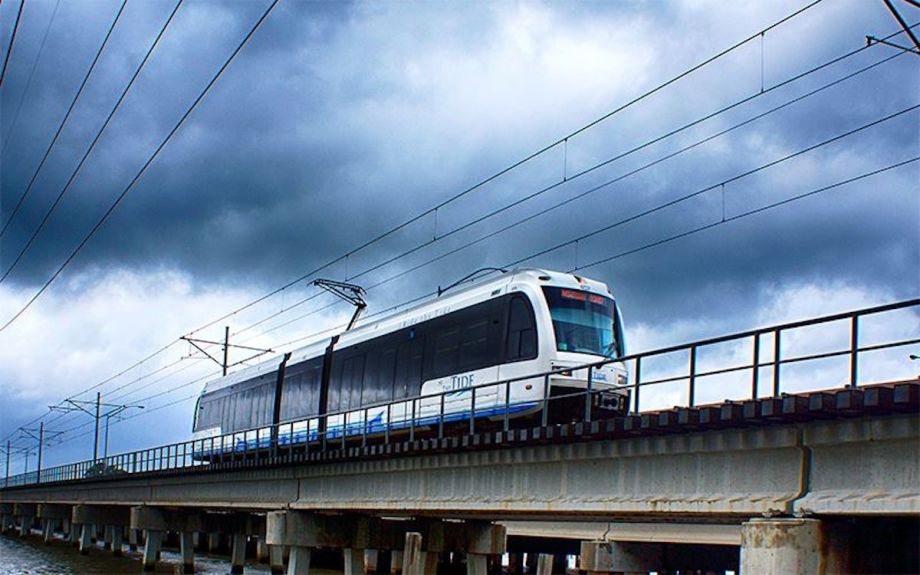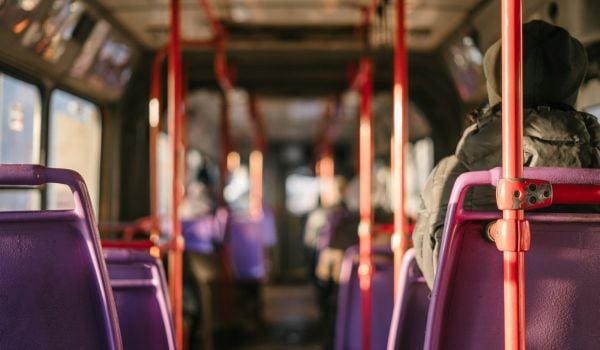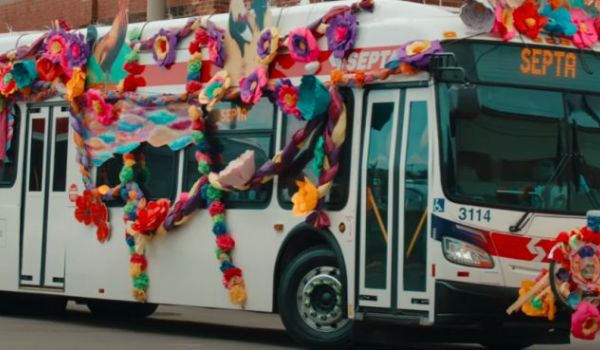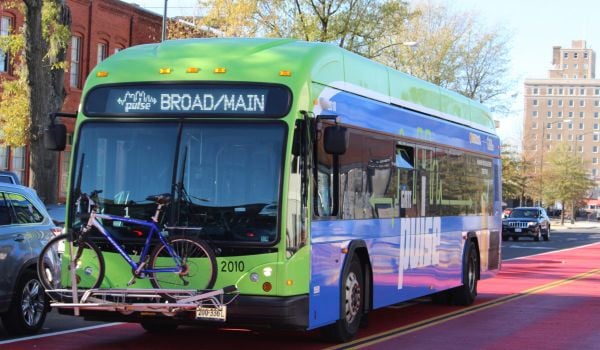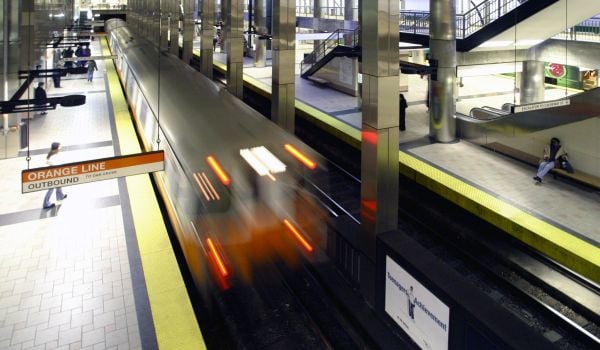Our weekly “New Starts” column of new and newsworthy transportation projects worldwide.
Virginia Beach Official Launches Anti-Tide Extension Campaign
A battle is shaping up over the proposed extension of Hampton Roads Transit’s (HRT) Tide LRT line from Norfolk into downtown Virginia Beach, and a Virginia Beach city official has decided to spearhead the fight against it.
WAVY reports that Virginia Beach City Treasurer John Atkinson has formed a political action committee to raise money and gather signatures in order to put a referendum on the extension on the November 2016 election ballot.
Virginia Beach’s City Council has already set aside $20 million toward the line’s construction. Atkinson has been opposed to the project from the start. He told WAVY that he was moved to launch a formal opposition campaign when a Brookings Institution report named the Tide LRT line as the most heavily subsidized rail transit system in the United States, with an average loss of $6.63 per passenger ride.
“It’s a very expensive proposition for the citizens of Virginia Beach,” Atkinson told WAVY.
Since 4,000 readers responded to a newspaper ad Atkinson ran in June urging opposition to the line, he has raised $40,000 for his campaign from local residents.
Mayor Will Sessoms, an LRT supporter, pointed out that there had been a referendum on the extension in the last presidential election and that the exact cost of the line has not yet been determined.
Kuala Lumpur Starts Work on Second Phase of Metro Project
The Malaysian government has given Kuala Lumpur’s Mass Rapid Transit Corporation (MRT) the go-ahead to start work on the second phase of a metro line serving the Klang Valley in the national capital.
The International Railway Journal reports that the 52.2-km (32.4-mile) Klang Valley MRT Line 2 project will connect Sungai Buloh with Serdang and Putrajaya.
The approval came after a three-month public consultation process in which more than 40,000 people viewed plans for the route. Of those, 10,500 offered feedback, and 90 percent of the comments supported it.
Nearly 14 km (almost nine miles) of the route will run in a subway between Jalan Ipoh and Kuchai Lama, and 38.7 km (24 miles) will run on an elevated viaduct. The route will have 37 stations — 25 elevated, 11 underground and one in an open cut.
The line’s first segment, from Sungai Buloh to Kampung Batu, is scheduled to enter service in July 2021; the remainder of the line from Kampung Batu to Putrajaya Sentral should open in July 2022.
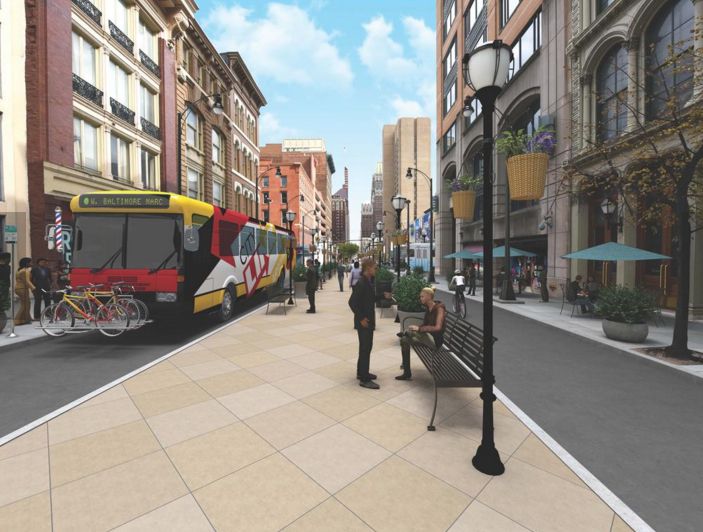
Rendering of Baltimore street with dedicated bus lane (Credit: Maryland Department of Transportation)
Hogan Announces Baltimore Bus System Makeover
Maryland Gov. Larry Hogan incensed elected officials in Baltimore when he pulled the plug on the proposed Red Line LRT project, which would have run east-west from Woodlawn in Baltimore County to Johns Hopkins Bayview in the city. They were further upset when he announced $1.9 billion in highway and bridge projects for the rest of the state but nothing for Baltimore in the wake of killing the $2.9 billion project.
Last week, Hogan announced that he would be giving Baltimore some transportation love — in the form of a top-to-bottom restructuring of the city’s bus network to provide faster, more frequent service and better connections to job centers, including suburb-to-suburb services. Total price tag for the improvements: $135 million.
As described in a Baltimore Business Journal story, Hogan’s proposal would replace existing bus routes into and through the city center with a network of 12 color-coded lines that would operate in reserved lanes through downtown Baltimore. (The plan envisions two downtown streets being converted into bus-only transitways, but city signoff will be required to close the streets to mixed traffic and the $135 million includes funds for engineering and design but not construction of the transitways.) Signal priority technology would enable these routes to run faster crosstown. Five new express bus routes would operate between suburban job centers starting next June, and six transit hubs would be created at key MARC regional rail, subway, light-rail and bus stations. (Maps of the current and future systems can be viewed here.)
The new and improved services, operating under the BaltimoreLink banner, would all be in place by 2017.
“It is unacceptable for Maryland’s largest and most important city to have an antiquated and broken transit system,” Hogan said at a news conference announcing the changes. “Perhaps even worse is both city and state leaders have largely ignored these failings of our system for decades. Beginning today, that is going to change.”
The chief executives in both Baltimore City and County were cool toward the proposal, while the president of Baltimore City Council welcomed the proposed changes. Baltimore Mayor Stephanie Rawlings-Blake said Hogan’s plan would not provide the economic development benefits the Red Line would have, and Baltimore County Executive Kevin Kamenetz said the plan would “leave the Baltimore region stuck in traffic.” Baltimore City Council President Bernard C. “Jack” Young said he looked forward to working with the Governor to improve bus service and connect Baltimoreans to “the growing number of jobs in the region.”
A Baltimore Sun editorial was also mildly critical of the Governor’s plan, calling its goals “worthwhile but a lot more challenging and expensive than Mr. Hogan has acknowledged.”
Know of a project that should be featured in this column? Tweet with links to @MarketStEl using the hashtag #newstarts.
The Works is made possible with the support of the Surdna Foundation.

Next City contributor Sandy Smith is the home and real estate editor at Philadelphia magazine. Over the years, his work has appeared in Hidden City Philadelphia, the Philadelphia Inquirer and other local and regional publications. His interest in cities stretches back to his youth in Kansas City, and his career in journalism and media relations extends back that far as well.
Follow Sandy .(JavaScript must be enabled to view this email address)


